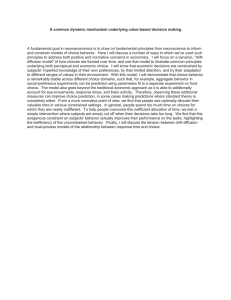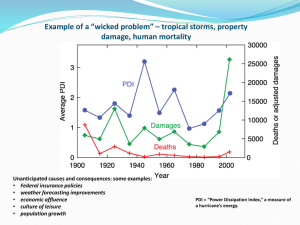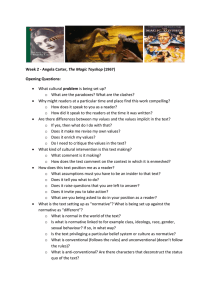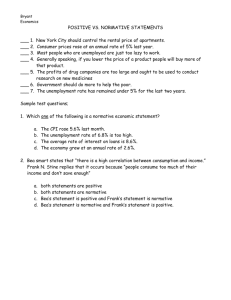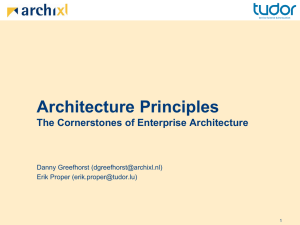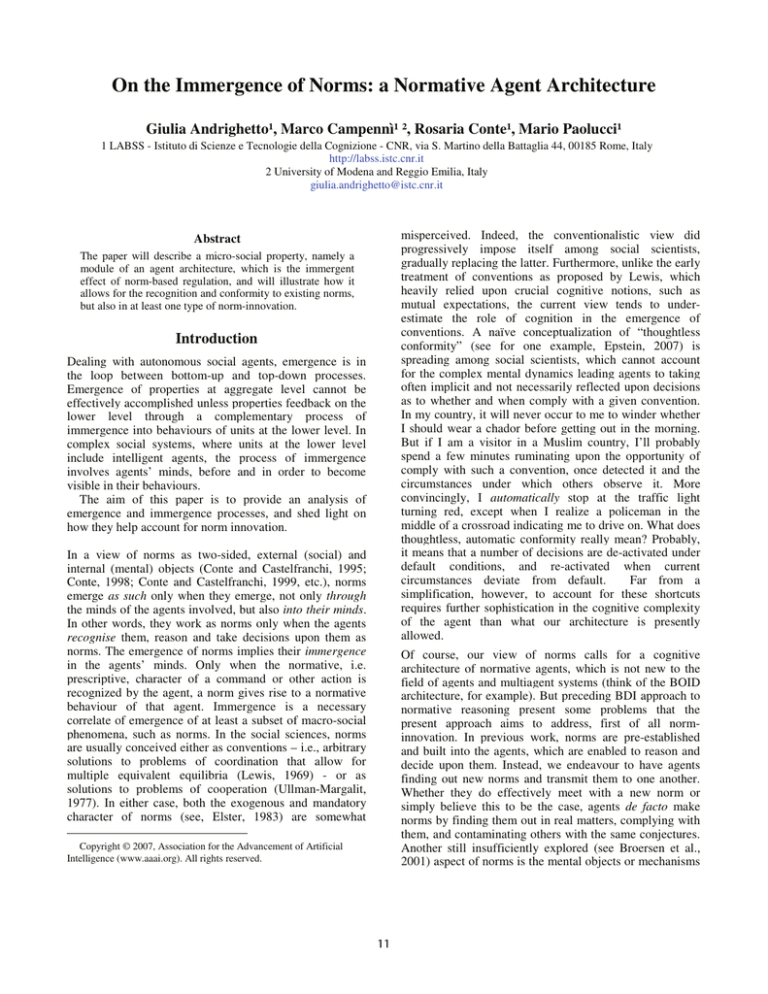
On the Immergence of Norms: a Normative Agent Architecture
Giulia Andrighetto¹, Marco Campennì¹ ², Rosaria Conte¹, Mario Paolucci¹
1 LABSS - Istituto di Scienze e Tecnologie della Cognizione - CNR, via S. Martino della Battaglia 44, 00185 Rome, Italy
http://labss.istc.cnr.it
2 University of Modena and Reggio Emilia, Italy
giulia.andrighetto@istc.cnr.it
misperceived. Indeed, the conventionalistic view did
progressively impose itself among social scientists,
gradually replacing the latter. Furthermore, unlike the early
treatment of conventions as proposed by Lewis, which
heavily relied upon crucial cognitive notions, such as
mutual expectations, the current view tends to underestimate the role of cognition in the emergence of
conventions. A naïve conceptualization of “thoughtless
conformity” (see for one example, Epstein, 2007) is
spreading among social scientists, which cannot account
for the complex mental dynamics leading agents to taking
often implicit and not necessarily reflected upon decisions
as to whether and when comply with a given convention.
In my country, it will never occur to me to winder whether
I should wear a chador before getting out in the morning.
But if I am a visitor in a Muslim country, I’ll probably
spend a few minutes ruminating upon the opportunity of
comply with such a convention, once detected it and the
circumstances under which others observe it. More
convincingly, I automatically stop at the traffic light
turning red, except when I realize a policeman in the
middle of a crossroad indicating me to drive on. What does
thoughtless, automatic conformity really mean? Probably,
it means that a number of decisions are de-activated under
default conditions, and re-activated when current
circumstances deviate from default.
Far from a
simplification, however, to account for these shortcuts
requires further sophistication in the cognitive complexity
of the agent than what our architecture is presently
allowed.
Abstract
The paper will describe a micro-social property, namely a
module of an agent architecture, which is the immergent
effect of norm-based regulation, and will illustrate how it
allows for the recognition and conformity to existing norms,
but also in at least one type of norm-innovation.
Introduction
Dealing with autonomous social agents, emergence is in
the loop between bottom-up and top-down processes.
Emergence of properties at aggregate level cannot be
effectively accomplished unless properties feedback on the
lower level through a complementary process of
immergence into behaviours of units at the lower level. In
complex social systems, where units at the lower level
include intelligent agents, the process of immergence
involves agents’ minds, before and in order to become
visible in their behaviours.
The aim of this paper is to provide an analysis of
emergence and immergence processes, and shed light on
how they help account for norm innovation.
In a view of norms as two-sided, external (social) and
internal (mental) objects (Conte and Castelfranchi, 1995;
Conte, 1998; Conte and Castelfranchi, 1999, etc.), norms
emerge as such only when they emerge, not only through
the minds of the agents involved, but also into their minds.
In other words, they work as norms only when the agents
recognise them, reason and take decisions upon them as
norms. The emergence of norms implies their immergence
in the agents’ minds. Only when the normative, i.e.
prescriptive, character of a command or other action is
recognized by the agent, a norm gives rise to a normative
behaviour of that agent. Immergence is a necessary
correlate of emergence of at least a subset of macro-social
phenomena, such as norms. In the social sciences, norms
are usually conceived either as conventions – i.e., arbitrary
solutions to problems of coordination that allow for
multiple equivalent equilibria (Lewis, 1969) - or as
solutions to problems of cooperation (Ullman-Margalit,
1977). In either case, both the exogenous and mandatory
character of norms (see, Elster, 1983) are somewhat
Of course, our view of norms calls for a cognitive
architecture of normative agents, which is not new to the
field of agents and multiagent systems (think of the BOID
architecture, for example). But preceding BDI approach to
normative reasoning present some problems that the
present approach aims to address, first of all norminnovation. In previous work, norms are pre-established
and built into the agents, which are enabled to reason and
decide upon them. Instead, we endeavour to have agents
finding out new norms and transmit them to one another.
Whether they do effectively meet with a new norm or
simply believe this to be the case, agents de facto make
norms by finding them out in real matters, complying with
them, and contaminating others with the same conjectures.
Another still insufficiently explored (see Broersen et al.,
2001) aspect of norms is the mental objects or mechanisms
Copyright © 2007, Association for the Advancement of Artificial
Intelligence (www.aaai.org). All rights reserved.
11
that allow them to affect the behaviours of autonomous
intelligent agents, or to state it other wise, that implement
them. Norms not only regulate behaviour but also act on
different aspects of the mind.
The Intra-agent Processes: EMIL-A
In this paper we will provide an analysis of the so called
inter agents and intra agent processes needed to deal with
norm emergence. On the one hand, inter agents processes
contribute to characterize the transmission of the norm; on
the other hand, intra agent properties and processes define
its immergence. As to the inter-agents processes, special
attention will be paid to the mechanisms of emergence and
diffusion of entities or properties at the aggregate level,
from interaction among agents: this, aimed to point out
how this allows a norm to be innovated.
As to the intra-agent processes, attention will be drawn on
the normative architecture, EMIL-A necessary for its
achievement.
Norm-Innovation: a Special Case of Immergence
Before illustrating EMIL-A, let us propose an operational
taxonomy of norm-innovation. Norms are a highly
adaptive artefact, emerging, evolving, and decaying. If it is
relatively clear how legal norms are put into existence and
then abrogated, it is much less obvious how the same
process may concern social norms. How do new social
norms and conventions come into existence, and how are
they abandoned? Lewis’s (1969) theory of conventions
does not account for the formation of shared reciprocal
expectations of conformity.
Figure 1: The main components of EMIL-A. It consists in four
different procedures, indicated by the dotted boxes, three mental
objects and a long term and working memory, indicated by the
continuous boxes and a Moral Internalized Attitudes, indicated by
the indented box. The dotted arrows indicate the act of asking,
searching or activating and the two-directed continuous arrows
the act of depositing.
Figure 1 illustrates the components of EMIL-A, consisting
in:
Four different procedures:
Indeed, some simulation studies about the selection of
conventions have appeared of late, for example Epstein
and colleagues’ study of the emergence of social norms
(2007), and Sen and Airiau’s study of the emergence of a
precedence rule in the traffic (2007). However, such
studies investigate which one is chosen from a set of
alternative equilibria.
•
•
•
•
A rather different sort of question concerns the
innovation of social norms when no alternative equilibria
are available for selection. We envisage at least three
possible types of norm-innovation: 1. Norm-adaptation and
extension: 2. Norm-instantiation 3. Norm-integration.
Norm Recognition, containing the Normative
Frame;
Norm Adoption, containing the Goal Generation
Rule;
Decision Making;
Normative Action Planning.
Three different metal objects:
•
•
•
In the present paper, we will address only the case of
norm instantiation, illustrating how our normative
architecture EMIL-A allows a new norm to be perceived
and established as an instance of an existing norm.
Normative Beliefs;
Normative Goals;
Normative Intentions.
An inventory:
•
Copyright © 2007, Association for the Advancement of Artificial
Intelligence (www.aaai.org). All rights reserved.
A Normative Long Term Memory, containing a
Normative Board and a Repertoire of Normative
Action Plans.
Copyright © 2007, Association for the Advancement of Artificial
Intelligence (www.aaai.org). All rights reserved.
12
A Moral Internalized Attitudes Module that,
retroacting on the other procedures, can activate or
deactivate them or directly impact on goals.
Counterfactuals
The different parts of EMIL-A are necessary to deal with
some tasks and theoretical questions, crucial to the
normative domain:
The outputs of EMIL are two different kinds of normative
actions, compliance/violation and/or norm-defense.
•
Without a norm-recognition module, we could not rule
out pure coercion, or in other words discriminate
between a norm and a mere coercion. Norms are more
than mere commands of private agents obliging us to
do or not to do something. The binding force is
insufficient, since it also characterizes non-normative
commands. The norm recognizer, endowed with the
normative frame and able to have access to the base of
knowledge stored in the normative board, shall attempt
to give an answer to this crucial question.
• Without norm-adoption, how account for agents’
autonomy? Normative agents ought to be granted
reasoning and autonomy. Exposed to normative
requests, they must decide whether to adopt it or not.
• Without normative decision making, how account for
norm violation, and conflict resolution? A normative
goal is not sufficient for agents to comply with norms.
Several factors occurring within the process leading
from normative goals to normative actions may cause
agents to abandon the goal and violate the norm. One
of such factors is conflicting (normative) goals. The
decision maker helps decide whether and which
(normative) goals to pursue on the grounds of their
urgency and of the existing beliefs.
• Without normative action of defense, how account for
social control? This is decisive for spreading the
norms through a population of autonomous agents.
Norm defense is based on a normative equity
principle, which wants agents to sustain normative
costs no higher than those sustained by other subjects
to the same norm, benefits being equal.
As we will try to point out in the second part of this paper,
the whole normative architecture, together with the inter
agent processes, are necessary to deal with norm
innovation.
In the rest of the paper, the main relevant features of
EMIL-A will be introduced and discussed. In particular we
will pay attention to:
• the functioning and role of the norm recognition
module;
• the positive default bringing to the adoption of a
normative goal;
• the motivational aspects of the normative mental
representations;
• and the anticipatory and predictive nature of the
whole system.
Then we will try to clarify how agents above defined can
be involved in inter-agent processes; we will focus on the
norm instantiation as a case of norm-innovation process.
Related Work
In evolutionary psychology, there are many efforts to
define normative agents. Each definition focuses on one
specific aspect of the problem. To make one good
example, Sripada and Stich’s model mechanisms (2006) of
norm acquisition are proposed but no description how they
work is given. Analogously, norm compliance is taken for
granted without explaining how it works and to what
extent it is compatible with agents’ autonomy.
In AI, Broersen et al (2001) presents the so-called
Belief-Obligations-Intentions-Desires
or
BOID
architecture as a feedback loops mechanism, which
considers all effects of actions before committing to them,
and resolves conflicts between the outputs of its four
components: each type of agent corresponds to a specific
type of conflict resolution embedded in the BOID
architecture. In all of them it is not contemplated that an
agent can (or cannot) recognize an action as normative;
only if the agent recognizes it as such she can decide
whether to comply with it.
An other crucial feature rarely take into account is the
anticipatory and predictive nature of normative agents.
Anticipation (i.e. making decisions based on predictions,
expectations, or beliefs about the future) is a vital
component of autonomous cognitive agents living in social
systems (Miceli and Castelfranchi, 2002). Agents
incorporating reactive planning tend to be autonomous
systems proactively pursuing at least one, and often many,
goals. Anticipation enhanced performance of agents to face
with complex social environments where they have to
guide their attention to collect important (social)
information to (inter-) act (Pezzulo, 2007).
EMIL-A architecture, beeing a part of “general”
cognitive architecture, should be provided with this special
capability.
Normative Inputs
EMIL-A receives and is activated by internal and external
normative inputs.
External normative inputs are deontic commands,
prescribing that something is permitted, forbidden or
obligatory, communicated either by the legislator or from
other members of the community. In our terms
(Andrighetto et al. 2007; Andrighetto, Conte, Turrini,
2007), a norm is a prescription, or command, characterized
by the use of deontics, which are reasons and bases for
prescriptions. Deontics empower the command,
substituting and rendering the exercise of personal power
superfluous. This new kind of power may be exercised not
only by institutional authorities, which are formally
empowered, but also by private citizens with regard to one
13
another. In other words a norm is a deontic command,
whose power over is inherent to the deontic itself 1.
•
•
As to internal inputs, EMIL-A is activated:
•
•
by the general architecture of the agent:
sometimes the activation of goals in the agent’s
mind requires a sudden comparison with the
existing N-Goals of the agent herself: this to test
potential conflicts.
by internalized attitudes, including social
emotions and moral disposition, working as
internal drives to norm compliance.
of compliance;
and/or defence: either of direct or indirect
punishment or of norm spreading through
communication;
or eventually be abandoned, solution that brings again to
norm violation.
Norm Recognizer
The norm recognition module gives access to the EMIL-A
architecture. Before an input is recognized as normative,
the norm cannot immerge in the minds of agents and, as a
consequence, cannot emerge in society. Agents need to be
able to discriminate between norms and other social
phenomena, such as coercion, ordinary requests,
conventions, etc. Norm recognition explores the normative
frame and the normative board, often resorting to the
anticipatory and predictive capacity of the whole system
(see the simulator described below).
Our claim is that existing normative architectures so far
did not render justice to the recognition procedure. On the
contrary, this module is fundamental for norm innovation,
as we will argue in the second part of this paper.
Mental Path of The Norm
To have an idea of how EMIL-A works, a sketch of an
“ideal” and complete mental path of a norm will be
provided. Probably, the standard path is rarely followed in
its completeness and it is more plausible to consider that
shortcuts take place during the computation of the
normative input. For example, when you are driving and
you see a red traffic light you will automatically stop. In
this situation, it is not necessary that input follows the
complete mental path.
After recognition, a norm becomes a belief in the mind
of the agent stating that “there is a norm prohibiting,
prescribing, permitting…”. It is an Observer’s N-Belief
(Conte and Castelfranchi, 1995). It may also be stored as a
beliefs of pertinence stating that a norm exists and
concerns us.
Norms work through social goal-adoption, i.e. the fact
that x believes that y wants p, is a reason for x to have
(adopt) the goal that p, since and until y has it as a goal.
Thanks to the norm adoption mechanism, the normative
belief of pertinence activates a (preexistent) goal that, by a
goal generation rule 2, may generate a new, normative goal.
If no such a goal is generated, the norm is violated.
An agent endowed with this particular kind of goal is
allowed to compare it with any other goal (norm-decision
maker) of her and, to some extent, to choose which one
will be transformed in N-Intentions, i.e. in executable
goals.
The N-Goal can be transformed into a normative
intention (and than into an action, i.e. a performed goal):
The Normative Board. When EMIL-A has to deal with an
external input, such as a NO SMOKING sign, the norm
recognition module will explore the N-Board. Suppose a
corresponding normative belief is found (DO NOT
SMOKE WHEN PROHIBITED), a belief of pertinence is
fired that will follow the path described previously.
The normative board contains normative beliefs and
normative goals, organized and arranged according to
salience that these normative objects have gained. With
salience we refer to the norm’s degree of activation, which
is a function of its consistency with (shared) moral
dispositions: in a particular situation a norm is more
consistent than others, so its salience is higher. There are
two types of salience:
•
•
objective salience is valid for all agents in the
same context;
subjective salience originates from past
experience and from own history.
The difference in salience between N-Beliefs and NGoals has the effect that some of these normative mental
objects will be more active than others and they will
interfere more frequently and with more strength with the
general cognitive processes of the agent.
1
Although necessary for the spreading of the prescribed
behaviour, the normative command is insufficient: additional
factors consist of the mandatory force (obligatoriness and
enforcement) of the command; the persuasiveness and credibility
of the source; compatibility with existing norms (norm conflicts
often lead to violating one or the other); etc.
The Normative Frame. If it is the case that the normative
external input is an unknown norm the normative frame
will be activated. It is a dynamic schema that allows us to
recognize and categorize an external input as normative. It
contains the properties defining a norm (Andrighetto,
Conte, Turrini, 2007):
2
The goal-generation rule (Conte and Castelfranchi, 1995):
If x has goal p and x believes that q is one of p's antecedents, then
x will also have goal q.
14
Agents don’t need to understand nor agree about the
specific function of a norm. They must respect it because it
is a norm (or, sub-ideally, because of surveillance and
sanctions), but in any case, they need first to recognize it is
a norm.
The properties defining a norm are variables that can
assume values within a defined range.
The normative frame works as a simulator, which helps
interpret or forecast the nature of the inputs agents come
across with. If, for instance, one of the properties of the
input matches with one of the variables listed above, a
normative interpretation is put forward. Successive
experience will either confirm or dismantle this hypothesis.
In the meantime, the other slots will be left in standby
until the hypothesis is either verified or rejected. If further
checks are confirmatory, the agent will form a new
normative belief. The Normative Frame, thanks to our
modelling, allows to recognize a norm even if detecting
only few (salient) normative properties; thanks to them the
other properties will be deduced by default.
To simulate the results of a hypothesis, the normative
frame must be interfaced with the agent’s knowledge of the
world. Simulations helps the agent to recognize unknown
norms, disambiguate opaque interpretations and forecast
the effects of different decisions.
Deontic: a way of partitioning situations between
good/acceptable ones and bad/inacceptable ones. We
distinguish deontics into:
•
•
•
obligations;
forbearances;
permissions.
Source: the locus from which the norm emanates. We
distinguish the source into:
•
•
personal;
impersonal.
Role: the partition of the agents involved in a norm. We
distinguish:
•
•
•
•
Legislators, the personal source;
Addressees, those agents that are mentioned
by the norm as allowed or not allowed to
carry out a given action;
Defenders, that is those agents that share and
enforce the norm;
Observers, those that acquires beliefs about a
norm, that is whether it is enforced, violated,
emanated.
Rather than conjecturing an innate and universal
disposition to norm compliance, a hypothesis that
evolutionary psychologists would probably subscribe too
(but see also Horne 2007), we propose that normative
recognition be seen as an inbuilt property of intelligent
social agents, and an immergent effect of social regulation.
Unlike moral dispositions, it is poorly sensible to
subjective variability, and rather robust. It allows us to (a)
account for the universal appearance of norms in human
and primate societies; (b) render justice to the intuition that
humans may violate norms, but have little problems in
telling norms; (c) account for the evolutionary
psychological evidence (see Cosmides and Tooby, 1992)
showing that agents easily apply counterfactual reasoning
to find out social rules, but find it difficult to do so with
logical ones; finally, (d) explain why, as pointed out by
developmental psychology data, norm acquisition follows
a stable ontogenetic pattern starting quite early in
childhood (Nucci, 2001; Cummins, 1996; Piaget, 1965;
Kohlberg, and Turiel, 1971).
In short, the intuition behind our normative architecture
is twofold: on one hand, dealing with norms is based upon
a universal capacity to tell norms, on the other this capacity
is supported by a norm frame, an internal “model of a
norm” that agents use as a frame of reference. As we will
stress later, norms also have a motivational effect. This
claim is again supported by evolutionary psychologists
(see for example, Cosmides and Tooby, 1992), who refer
to this type of motivation as intrinsic and granted by an
innate normative module. We would like to object to this
view that the existence of a norm module is either too
strong or insufficient: it is too strong because it leaves no
Enforcement mechanism: operations that attempt to modify
agents' actions in order to make them compliant to a norm.
We distinguish:
•
•
sanctions: enforcement mechanisms that
inhibit agents' actions;
incentives: enforcement mechanisms that
favour agents' actions.
Control: the way enforcement mechanisms are applied. It
implies both monitoring - that checks violation - and
influence - that actively pushes cognitive agents' towards
compliance. They can be:
•
•
centralized: only one agent (individual or
supraindividual) is entitled to sanction;
distributed: everybody is able to defend the
norm.
However, not all the slots need be filled in for a norm to
be recognised. What is needed is that agents recognise
•
•
•
•
the prescriptive and impersonal character of the N
(Conte, and Castelfranchi, 2006);
the entitled, legitimate/valid, in force and
impersonal nature of the authority;
the application of the norm erga omnes;
the legitimate reactions or sanctions to
transgressions.
15
room to autonomy and norm violation. It is insufficient
because little is said about how it effectively works: what
are norms? How are they learned? What is their internal
processing, the path they follow in the mind? The
motivational nature of the norm can be understood only if
we explode such complex mental representations in their
components, N-Beliefs, N-Goals and N-Intentions, and pay
attention to the mental path they follow and to the
procedures and rules that assure their elaboration. The
emphasis laid on the innate and universal features of
EMIL-A should not be mistaken, leading to think that no
space is left to subjective variability. If norm recognition is
a must, equally accomplished by a vast majority of agents,
moral attitudes - i.e. the results of normative and moral
experience accumulated during lifetime that affect different
normative procedures - are not. They are definitely
subjective.
Furthermore, the reinforcement effects that occur on
different EMIL-A procedures vary among agents.
Personal experience, for example, impacts norm salience.
Analogously, the normative frame, being in constant
interaction with the social environment and the other
procedures, is liable to their influence. In these terms, a
normative architecture is allowed to elegantly ignore the
culture/nurture controversy.
−
−
agent 1 is a recently qualified driver; probably for
her the norm stop-if-traffic_light-is-red is urgent
because she feels uncertain in driving;
agent 2 is an expert driver; she feels selfconfident at driving and she finds the normcompliance less cogent.
In sum, after a normative request a normative goal gets
formed in the mind of the addressee. The agent takes it into
account, and tends to accept it unless there are good
reasons for not doing so. This way of reasoning is inherent
to the normative dimension, and diverges from a general
modality of reasoning and social reasoning.
Inter-agents Processes: a Scenario of Norm
Innovation
Let us better define the norm-innovation taxonomy above
presented. Based on a gradient of novelty, we identified
three main categories of norm innovation,
•
norm extension or adaptation: an existent norm is
extended to new entities or social category, in such a
way that its content is modified;
• norm instantiation: a new norm is perceived and
established as an instance of an existing norm;
• norm integration: a norm is determined by the
integration of conflicting norms.
To better understand this process, it is necessary to
examine at least one type of norm innovation, namely
norm instantiation.
Usually, there are at least two agents involved in an
episode of norm innovation: an agent source executing a
given (normative) action and an agent observing it.
Towards Norm Adoption
Imputed by normative requests, the agent will generate a
normative goal thanks to the norm adoption procedure.
This does not imply, by the way, that the request will
certainly be complied with. Our claim is rather that,
whenever an input gives rise to a normative belief of
pertinence, a new process starts: the agent wonders why not
to adopt it. In short, we believe agents have a weak
disposition, a positive default, to take normative requests
into account and adopt them unless there are good reasons
not to do so. Unlike ordinary adoption, in which agents
must have positive reasons for adopting others’ requests, in
norm adoption a baseline reason is provided, as pointed out
before, by the deontic itself: either one does not recognise
it under a command, or one believes there is a good reason,
however feeble, for accepting the command. The
normative goal may be extremely weak, and its value may
be re-evaluated later on, when the decision making
procedure will compare the effects of violation with the
costs of compliance. Suppose that at night, while
approaching a crossroad, I see the traffic light turning red.
It is late in the night and neither cars nor pedestrians are
visible. It is also most unlikely that any policeman is
observing me. In this situation, together with the costs of
violation, also the value of the normative goal decreases.
We define cogency the criterion for choosing whether to
execute a (normative) goal or not, and compares the costs
of executing it with the effects of dropping it; while
salience is the ranking order of norms, and is related to
other norms. Getting back to our example, we can have
two different agents:
Figure 2
Copyright © 2007, Association for the Advancement of Artificial
Intelligence (www.aaai.org). All rights reserved.
16
−
Figure 3.
−
At time t + 2, in any case, once a N-action has
been taken path-dependence reinforces the
normative “path”: if Observer finds a “similar”
situation, it will be induced to choose the same
path. In this case, Observer reacts to the anomaly
as in the previous case, but the probability of each
reaction is not static, predetermined; there is a
dynamic process: if Observer chooses to interpret
the action as a normative one, this choice is more
reinforced than others, its probability increases
each time and as a consequence that of others
decreases.
Each time, the normative choice gains more and more
weight; the synergy of the normative board and the
repertoire of normative action plans impact on the
probability of normative interpretation. The Observer’s
normative action reinforces her choice and that of other
observers (if any). Hence, this mechanism is crucial for
norm innovation.
What happens if there is more than one observer?
Presumably, the self-reinforcing choice mechanism works
both within the agent (for each observer) and between
them: the level of activation in the normative board
reinforces the interpretation of each observer and her
normative action reinforces both her normative choice and
that of the next one. This dynamic process involves NBeliefs and N-Goals in the normative board and N-actions
in the repertoire of N-action plans: each time a nth
normative belief is active (i.e. it is salient), the normative
interpretation is reinforced. Moreover, the consequent
normative action reinforces the normative interpretation.
In the case of more-than-two observers, we find an
avalanche effect of normative interpretation reinforcement:
each observer reinforces not only her own normative
interpretation in two steps (normative board and normative
action), but also that of the next one with her normative
action. Norm innovation is an inherently inter-agent
process: only observers can innovate norms, since they
need to perceive implicit commands, or adopted commands
in a Source’s behaviour. The new action may be even
Figure 4.
Figures 2-4: Arrows between source and observer stand for
possible choices; the thicker the arrow, the more likely the
corresponding choice. Continuous boxes represent agents;
arrows pointing to boxes stand for causal processes. Curved
continuous arrows represent reinforcing effects: when EMIL-A
agent consults its normative board, it may receive an answer that
reinforces the normative choice. Dotted curved arrows represent
the same process at time t+1.
Let us analyse the situation step by step, over time.
− At time zero (t = 0) Source has a Goal that
produces an Intention, and finally an Action.
− At time t + 1 (i.e. t = 1), Observer perceives that
action. If Observer finds an anomaly with respect
to current habits (anomaly plays a decisive role
because it elicits interpretation), there are two
possible scenarios:
−
thoughtlessly (25%); or else she may
choose Source because she perceives her
as successful (intelligent social learning,
25%); Observer may decide to ignore the
anomaly (25%) and behave as usual;
finally, Observer may decide to consider
the action as normative (25%).
salience: if there is a high state of
activation of a given nth N-Belief and NGoal in the normative board and if the
anomaly observed is consistent with it,
the probability of interpreting the action
observed as normative becomes higher
than any other option; Observer will
execute a nth N-action in the repertoire
of normative plans.
equiprobability: in principle in absence
of elements that can help us to decide,
we have the same probability p for each
option ( p = 1 / number of choices):
Observer
can
imitate
Source
17
produced accidentally; nonetheless, if it fits salient norms,
it may easily be interpreted as an instance of it. Once this
interpretation has been done, the job is done: the higher the
number of observers at subsequent times, the more likely
and fast a new norm will establish.
References
Andrighetto, G.; Conte, R.; Turrini, P.; and Paolucci, M.
2007. Emergence In the Loop: Simulating the two way
dynamics of norm innovation. In Proceedings 07122 of the
Dagstuhl Seminar on Normative Multi-agent Systems,
Dagstuhl, Germany.
Andrighetto, G.; Conte, R.; and Turrini, P. 2007. EMIL
Ontology, Technical Report, 00307, LABSS-ISTC/CNR.
Barkow, J.; Cosmides, L.; and Tooby, J. 1992. The
Adapted Mind: Evolutionary psychology and the
generation of culture. NY: Oxford University Press.
Broersen, J; Dastani, M.; Hulstijn, J.; Huang, Z.; and van
der Torre, L. 2001. The BOID Architecture. Conflicts
Between Beliefs, Obligations, Intentions and Desires, In
Proceedings of the fifth international conference on
Autonomous agents, Montreal, Quebec, Canada. 9 – 16.
Conte, R., and Castelfranchi, C. 1995. Cognitive and social
action, London: London University College of London
Press.
Conte, R. 1998. L'obbedienza intelligente. Bari: Laterza.
Conte, R., and Castelfranchi, C. 1999. From conventions to
prescriptions. Towards a unified
theory of norms. AI&Law 7: 323-340.
Conte, R., and Castelfranchi, C. 2006. The Mental Path of
Norms. Ratio Juris 19 (4): 501 – 517.
Cummins, D. D. 1996. Evidence for deontic reasoning in
3- and 4-year olds. Memory and Cognition 24(6): 823-829.
Epstein, J. M. 2006. Generative Social Science. Studies in
Agent-Based Computational Modeling. Princeton-New
York: Princeton University Press.
Horne, C. 2007. Explaining Norm Enforcement.
Rationality and Society 19(3): forthcoming.
Kohlberg, L., and Turiel, E. 1971. Moral development and
moral education. In G. Lesser, ed. Psychology and
educational practice. Scott Foresman.
Lewis, D. K. 1969. Convention: A Philosophical Study.
Cambridge Mass.: Harvard University Press.
Miceli, M., and Castelfranchi, C. 2002. The mind and the
future: The (negative) power of expectations. Theory &
Psychology, 12, 335-366.
Nucci, L. P. 2001. Education in the Moral Domain.
Cambridge University Press.
Pezzulo, G. 2007. Anticipation and Future-Oriented
Capabilities in Natural and Artificial Cognition. In
Proceedings of the 50th Anniversary of Artificial
Intelligence, 67-70. Springer LNAI.
Piaget, J. 1965. The moral judgment of the child. The Free
Press: New York.
Sen, S., and Airiau, S. 2007. Emergence of norms through
social learning. In Proceedings of the Twentieth
International Joint Conference on Artificial Intelligence.
Forthcoming.
Sripada, C., and Stich, S. 2006. A Framework for the
Psychology of Norms. In P. Carruthers, S. Laurence and S.
Stich, eds., The Innate Mind: Culture and Cognition, 280301, Oxford University Press.
Ullman Margalit, E. 1977. The Emergence of Norms.
Oxford: Clarendon Press.
Conclusions and Future Works
In this paper we have proposed a Normative Architecture
of the Agent, EMIL-A, which is the immergent effect of
norm-based regulation, and we have illustrated how it
allows for the recognition and conformity to existing
norms, but also in at least one type of norm-innovation.
As pointed out, this point of view implies a dynamical,
anticipatory and interactive attitude with respect to the
social environment. Anyway, the model sketched in this
paper is still in progress: further investigation and a full
implementation are needed. In particular, we are aware of
the risk of an excess of consistency in EMIL-A, derived by
the reinforcement effects inside the model, that could be
avoided only by introducing some sort of variation.
We are also aware that:
•
•
a
deeper integration
between
EMIL-A
components
and the modelling of a certain number of shortcuts
taking place during the computation of the
normative input
would guarantee the architecture more plausibility.
The achievement of these tasks is a starting point for future
works.
Acknowledgments
This work was supported by the EMIL project (IST033841), funded by the Future and Emerging Technologies
programme of the European Commission, in the
framework of the initiative “Simulating Emergent
Properties in Complex Systems”. The EMIL-A normative
architecture owes its denomination to the above mentioned
EMIL Project, since it is developed within its frame.
We would like to thank EMIL partners and in particular
Rainer Hegselmann and Klaus G. Troitzsch for helpful
comments on previous versions of this paper.
We would also thank Federica Mattei for the linguistic
revision of the paper.
Copyright © 2007, Association for the Advancement of Artificial
Intelligence (www.aaai.org). All rights reserved.
18


